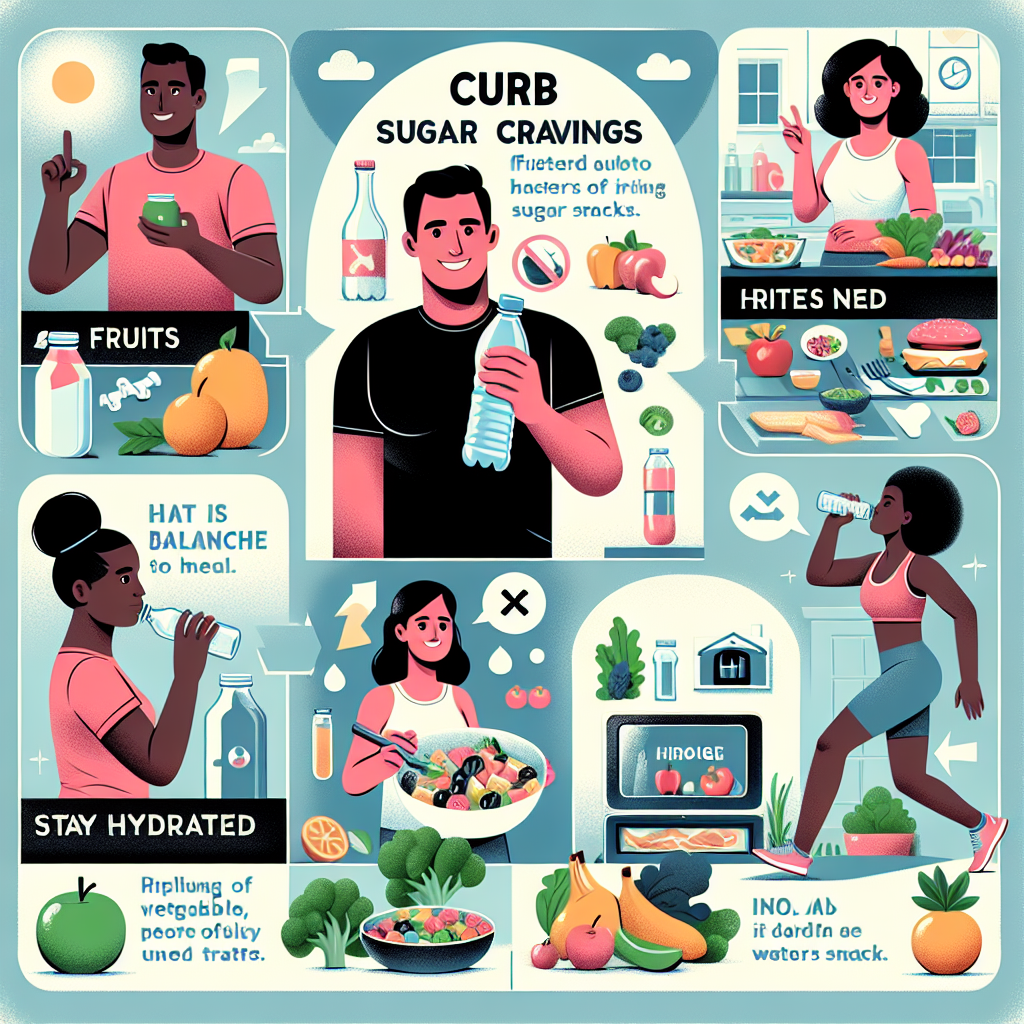How to Curb Sugar Cravings

Ready to curb your sugar cravings? Learn effective strategies and tips on our website. Click here to start your journey towards a healthier lifestyle today!
Effective Strategies to Overcome Sugar Cravings
Sugar cravings can be a formidable adversary for anyone trying to maintain a healthy diet. They can strike at any time, often leading to overindulgence in sweets and other sugary treats. However, there are effective strategies to overcome these cravings and maintain a balanced diet.
Firstly, it’s essential to understand why we crave sugar. Our bodies naturally crave high-energy foods, and sugar is a quick source of energy. However, consuming too much sugar can lead to weight gain, diabetes, and other health problems. Therefore, it’s crucial to find ways to curb these cravings.
One effective strategy is to eat regular, balanced meals. When we skip meals or go too long without eating, our blood sugar levels drop, leading to increased sugar cravings. By eating regular meals filled with lean proteins, whole grains, and plenty of fruits and vegetables, we can keep our blood sugar levels stable and reduce cravings.
Another strategy is to stay hydrated. Sometimes, our bodies can mistake thirst for hunger, leading us to reach for a sugary snack when what we really need is a glass of water. Drinking plenty of water throughout the day can help keep these false hunger signals at bay.
Additionally, getting enough sleep is crucial in curbing sugar cravings. Lack of sleep can disrupt our body’s hunger hormones, leading to increased cravings for sugar and other unhealthy foods. By ensuring we get a good night’s sleep, we can help keep our hormones in balance and our cravings in check.
Exercise is another powerful tool in the fight against sugar cravings. Physical activity helps regulate our mood and reduce stress, both of which can trigger sugar cravings. Even a short walk can help curb the desire for a sweet treat.
Mindful eating is also an effective strategy. This involves paying attention to what and when you’re eating, and why you’re eating it. Are you truly hungry, or are you bored, stressed, or tired? By being mindful of our eating habits, we can identify the triggers for our sugar cravings and find healthier ways to cope with them.
Lastly, it’s important to allow yourself a treat now and then. Completely denying yourself sugar can lead to feelings of deprivation and make cravings even stronger. By allowing yourself a small treat occasionally, you can satisfy your sweet tooth without going overboard.
In conclusion, while sugar cravings can be challenging to overcome, it’s certainly not impossible. By eating regular, balanced meals, staying hydrated, getting enough sleep, exercising regularly, practicing mindful eating, and allowing yourself the occasional treat, you can effectively curb your sugar cravings. Remember, the goal isn’t to eliminate sugar entirely, but to create a healthier relationship with food where you’re in control, not your cravings.
Understanding and Managing Your Sugar Cravings: A Comprehensive Guide

Sugar cravings are a common struggle for many individuals. They can be particularly challenging to manage for those trying to maintain a healthy diet or manage conditions such as diabetes. Understanding the root causes of these cravings and learning effective strategies to curb them can significantly improve one’s overall health and well-being.
Firstly, it’s essential to understand that sugar cravings are not merely a sign of a lack of willpower. They are often a physiological response to various factors, including hormonal imbalances, stress, and even certain nutrient deficiencies. For instance, when we’re stressed, our bodies produce more of the hormone cortisol, which can increase our desire for sugary foods. Similarly, deficiencies in nutrients like magnesium and chromium can also trigger sugar cravings.
Moreover, consuming sugar can create a vicious cycle. When we eat sugar, our brain releases dopamine, a neurotransmitter that makes us feel good. This feeling can be addictive, leading us to crave more sugar to experience the same pleasure. However, over time, this can lead to a higher tolerance for sugar, meaning we need to consume more to achieve the same dopamine high.
Now that we understand why we crave sugar, let’s delve into how we can curb these cravings. One effective strategy is to eat a balanced diet rich in whole foods. Whole foods like fruits, vegetables, lean proteins, and whole grains are packed with essential nutrients that can help balance our hormones and keep our blood sugar levels stable, reducing our desire for sugar.
Additionally, staying hydrated is crucial. Sometimes, our bodies can mistake thirst for hunger, leading us to reach for sugary snacks when what we really need is water. Therefore, drinking plenty of water throughout the day can help keep sugar cravings at bay.
Another strategy is to practice mindful eating. This involves paying attention to what and when you’re eating and listening to your body’s hunger and fullness cues. By eating slowly and savoring each bite, you can satisfy your sweet tooth with less food and avoid mindless snacking on sugary treats.
Regular physical activity can also help curb sugar cravings. Exercise not only helps regulate your blood sugar levels but also releases endorphins, chemicals in the brain that act as natural mood lifters. This can reduce your desire for the dopamine high that sugar provides.
Lastly, getting enough sleep is vital. Lack of sleep can disrupt your body’s hunger hormones, leading to increased sugar cravings. Therefore, ensuring you get a good night’s sleep can help keep your sugar cravings in check.
In conclusion, curbing sugar cravings is not about depriving yourself but rather about understanding the underlying causes and adopting healthy lifestyle habits. By eating a balanced diet, staying hydrated, practicing mindful eating, getting regular exercise, and ensuring adequate sleep, you can effectively manage your sugar cravings and improve your overall health. Remember, it’s okay to indulge your sweet tooth occasionally, but moderation is key.
Top Tips for Curbing Your Sweet Tooth and Reducing Sugar Intake
Sugar, the sweet culprit behind many health issues, is a substance many of us find hard to resist. Despite the well-documented health risks associated with excessive sugar consumption, such as obesity, diabetes, and heart disease, the allure of sugary treats can be hard to overcome. However, with a few strategic steps, it is possible to curb sugar cravings and reduce your sugar intake.
Firstly, it’s essential to understand that sugar cravings are often a sign of an underlying issue. For instance, they can be a symptom of blood sugar imbalances, nutrient deficiencies, or emotional stress. Therefore, addressing these root causes can be a powerful first step in curbing your sweet tooth. Regular meals packed with protein, fiber, and healthy fats can help maintain stable blood sugar levels, reducing the likelihood of sugar cravings. Similarly, ensuring you’re getting a full spectrum of nutrients, particularly magnesium, chromium, and B vitamins, can help keep cravings at bay.
Emotional eating is another significant factor in sugar cravings. Many people turn to sweet foods for comfort during times of stress, sadness, or boredom. Mindfulness techniques, such as meditation and deep breathing exercises, can help manage these emotions without resorting to sugar. Regular physical activity is also a potent stress reliever and mood booster, which can reduce the desire for sugary treats.
Another effective strategy for reducing sugar intake is to gradually decrease the amount of sugar you consume. Going cold turkey can lead to withdrawal symptoms and intense cravings, making it harder to stick to your sugar reduction goals. Instead, try reducing the amount of sugar you add to your coffee or tea, opt for unsweetened versions of your favorite foods and drinks, and gradually decrease the frequency of sugary treats.
It’s also important to be aware of hidden sugars in processed foods. Many products marketed as ‘healthy’ or ‘low-fat’ are loaded with added sugars to compensate for the lack of flavor. Reading food labels and choosing whole, unprocessed foods as much as possible can help you avoid these hidden sugars.
Hydration is another key factor in curbing sugar cravings. Dehydration can sometimes be mistaken for hunger or sugar cravings. Therefore, ensuring you’re drinking enough water throughout the day can help keep cravings in check. Additionally, drinking a glass of water when a sugar craving hits can help to curb the desire for something sweet.
Lastly, getting enough sleep is crucial for maintaining balanced blood sugar levels and reducing cravings. Lack of sleep can disrupt the hormones that regulate hunger and satiety, leading to increased sugar cravings. Therefore, prioritizing good sleep hygiene can be a powerful tool in your sugar reduction arsenal.
In conclusion, curbing sugar cravings and reducing sugar intake is not about deprivation, but about making healthier choices that support your overall wellbeing. By addressing underlying issues, gradually reducing sugar intake, staying hydrated, and prioritizing sleep, you can successfully curb your sweet tooth and enjoy the numerous health benefits of a lower sugar diet. Remember, it’s not about perfection, but progress. Every small step you take towards reducing your sugar intake is a victory worth celebrating.